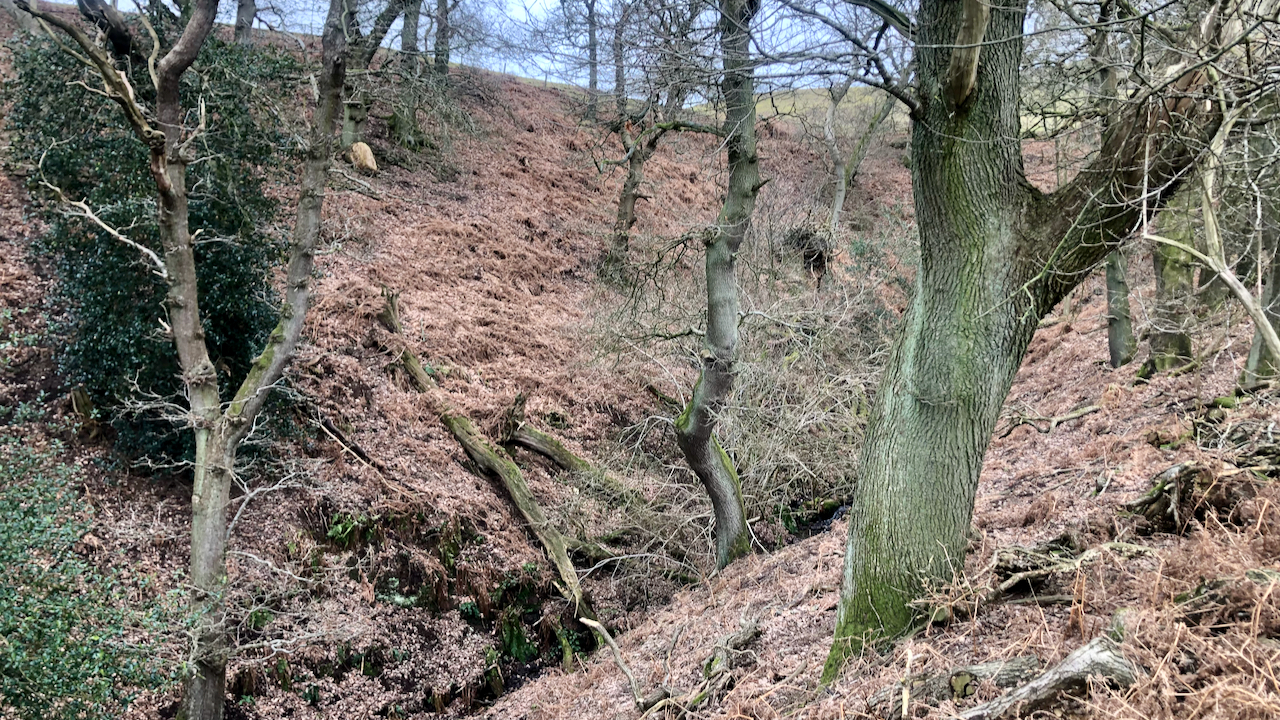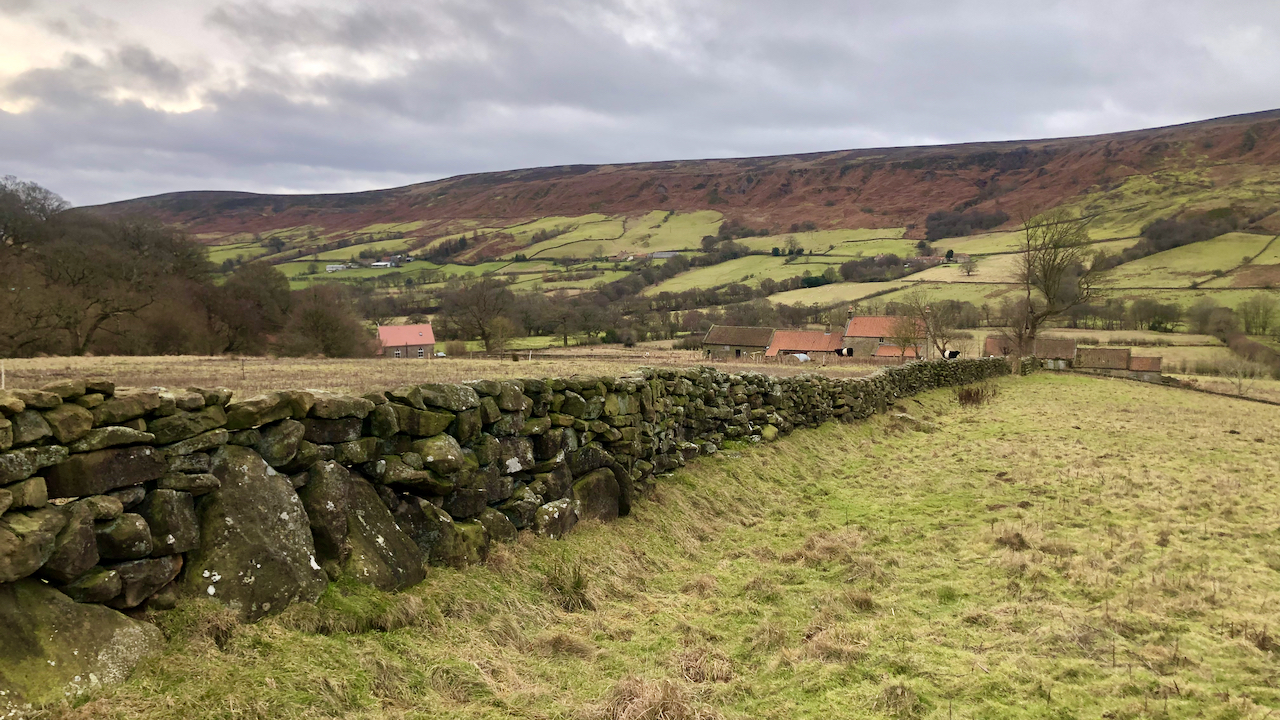A strange name for a farmstead, perhaps a reference to the post medieval trackway that can be discerned by a faint holloway parallel to the dry-stone wall in the photo1North York Moors Historic Environment Record (HER) No: 10777/13384. I once read that large earthfast boulders in a wall is an indication that the wall is of some antiquity.
The farm was a beneficiary of the Farming in Protected Landscapes scheme funded by DEFRA, the Department for Environment, Food and Rural Affairs, helping it move towards “regenerative farming practices“2Farming in Protected Landscapes Working in Partnership with Farmers and Land Managers to Look after Our Landscapes Together. [n.d.]. <https://www.northyorkmoors.org.uk/looking-after/advice-and-grants/farming-in-protected-landscapes/FiPL_casestudy_report_accessible.pdf> [accessed 2 February 2023]:
“The Farming in Protected Landscapes programme has contributed towards a portable water trough and pipework, along with rabbit netting. Belted Galloway cattle have recently been introduced to the holding, replacing the free-range pigs which were once farmed here. The cattle are moved twice a day and they now have access to water wherever they are set to graze. A herbal ley has been introduced, which is protected by rabbit netting – earlier attempts were decimated by the local rabbit population. This approach enables the farmer to manage the land without using artificial fertilisers. Soil health and structure are also now improving, aiding surface drainage and benefitting wildlife.”

It was the installation of this rabbit netting that resulted in my visit to Long Causeway today.
Sikehill Wood in Farndale is a 2ha National Trust property that is adjacent to Long Causeway and comprises a deep wooded gill. Records show it was not wooded until the 20th century but I find it hard to imagine any earlier agricultural use3‘MNA178888 | National Trust Heritage Records’. 2015. Nationaltrust.org.uk <https://heritagerecords.nationaltrust.org.uk/HBSMR/MonRecord.aspx?uid=MNA178888> [accessed 2 February 2023].
It was presented to the Trust in 1991 after being brought jointly by the Council for National Parks, the Rambler’s Association, the Council for the Protection of Rural England and the Open Spaces Society, with help from the Countryside Commission, to commemorate the life of Francis Ritchie, who “was one of the pioneers of the rambling movement who played a large part in the creation of the national parks in the 1940s and 50s“4Guardian staff reporter. 2006. ‘Adrian Ritchie’, The Guardian (The Guardian) <https://www.theguardian.com/news/2006/feb/14/obituaries.mainsection?CMP=gu_com#:~:text=his%20father%2C%20Francis%2C%20was%20one%20of%20the%20pioneers%20of%20the%20rambling%20movement%20who%20played%20a%20large%20part%20in%20the%20creation%20of%20the%20national%20parks%20in%20the%201940s%20and%2050s.> [accessed 2 February 2023]5‘ArcGIS Web Application’. 2023. Arcgis.com <https://national-trust.maps.arcgis.com/apps/webappviewer/index.html?id=59d0d36e5b3a44ae8cc49fe38d47ffd7> [accessed 2 February 2023].
Many of the posts for the stock fencing surrounding the wood had deteriorated and needed replacing.
One thing that did occur to me was that, although Sikehill Wood is ‘Open Access Land‘, there is no Public Right of Way actually into it. And in any case it doesn’t contain any paths being much too steep.
- 1North York Moors Historic Environment Record (HER) No: 10777/13384
- 2Farming in Protected Landscapes Working in Partnership with Farmers and Land Managers to Look after Our Landscapes Together. [n.d.]. <https://www.northyorkmoors.org.uk/looking-after/advice-and-grants/farming-in-protected-landscapes/FiPL_casestudy_report_accessible.pdf> [accessed 2 February 2023]
- 3‘MNA178888 | National Trust Heritage Records’. 2015. Nationaltrust.org.uk <https://heritagerecords.nationaltrust.org.uk/HBSMR/MonRecord.aspx?uid=MNA178888> [accessed 2 February 2023]
- 4Guardian staff reporter. 2006. ‘Adrian Ritchie’, The Guardian (The Guardian) <https://www.theguardian.com/news/2006/feb/14/obituaries.mainsection?CMP=gu_com#:~:text=his%20father%2C%20Francis%2C%20was%20one%20of%20the%20pioneers%20of%20the%20rambling%20movement%20who%20played%20a%20large%20part%20in%20the%20creation%20of%20the%20national%20parks%20in%20the%201940s%20and%2050s.> [accessed 2 February 2023]
- 5‘ArcGIS Web Application’. 2023. Arcgis.com <https://national-trust.maps.arcgis.com/apps/webappviewer/index.html?id=59d0d36e5b3a44ae8cc49fe38d47ffd7> [accessed 2 February 2023]

Leave a Reply